 |
| Reviews and Templates for Expression We |
This Tiny Country Feeds the World
The Netherlands has become an agricultural giant by showing what the future of farming could look like.
The great indoors provides optimal growing conditions for lettuce and other leafy greens at Siberia B.V. Each acre in the greenhouse yields as much lettuce as 10 outdoor acres and cuts the need for chemicals by 97 percent
In a potato field near the Netherlands’ border with Belgium, Dutch farmer Jacob van den Borne is seated in the cabin of an immense harvester before an instrument panel worthy of the starship Enterprise.
From his perch 10 feet above the ground, he’s monitoring two drones—a driverless tractor roaming the fields and a quadcopter in the air—that provide detailed readings on soil chemistry, water content, nutrients, and growth, measuring the progress of every plant down to the individual potato. Van den Borne’s production numbers testify to the power of this “precision farming,” as it’s known. The global average yield of potatoes per acre is about nine tons. Van den Borne’s fields reliably produce more than 20.
That copious output is made all the more remarkable by the other side of the balance sheet: inputs. Almost two decades ago, the Dutch made a national commitment to sustainable agriculture under the rallying cry “Twice as much food using half as many resources.” Since 2000, van den Borne and many of his fellow farmers have reduced dependence on water for key crops by as much as 90 percent. They’ve almost completely eliminated the use of chemical pesticides on plants in greenhouses, and since 2009 Dutch poultry and livestock producers have cut their use of antibiotics by as much as 60 percent.
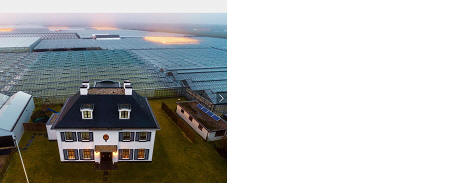
A sea of greenhouses surrounds a farmer’s home in the Westland region of the Netherlands. The Dutch have become world leaders in agricultural innovation, pioneering new paths to fight hunger.
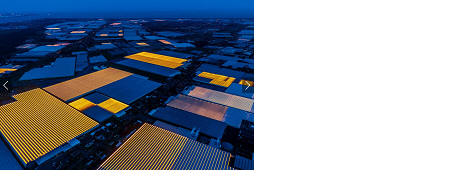
Furrows of artificial light lend an otherworldly aura to Westland, the greenhouse capital of the Netherlands. Climate-controlled farms such as these grow crops around the clock and in every kind of weather.
One more reason to marvel: The Netherlands is a small, densely populated country, with more than 1,300 inhabitants per square mile. It’s bereft of almost every resource long thought to be necessary for large-scale agriculture. Yet it’s the globe’s number two exporter of food as measured by value, second only to the United States, which has 270 times its landmass. How on Earth have the Dutch done it?
Seen from the air, the Netherlands resembles no other major food producer—a fragmented patchwork of intensely cultivated fields, most of them tiny by agribusiness standards, punctuated by bustling cities and suburbs. In the country’s principal farming regions, there’s almost no potato patch, no greenhouse, no hog barn that’s out of sight of skyscrapers, manufacturing plants, or urban sprawl. More than half the nation’s land area is used for agriculture and horticulture.
Banks of what appear to be gargantuan mirrors stretch across the countryside, glinting when the sun shines and glowing with eerie interior light when night falls. They are Holland’s extraordinary greenhouse complexes, some of them covering 175 acres.
These climate-controlled farms enable a country located a scant thousand miles from the Arctic Circle to be a global leader in exports of a fair-weather fruit: the tomato. The Dutch are also the world’s top exporter of potatoes and onions and the second largest exporter of vegetables overall in terms of value. More than a third of all global trade in vegetable seeds originates in the Netherlands.
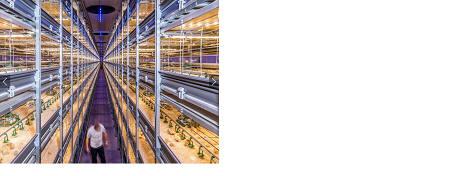
With demand for chicken increasing, Dutch firms are developing technology to maximize poultry production while ensuring humane conditions. This high-tech broiler house holds up to 150,000 birds, from hatching to harvesting.
The brain trust behind these astounding numbers is centered at Wageningen University & Research (WUR), located 50 miles southeast of Amsterdam. Widely regarded as the world’s top agricultural research institution, WUR is the nodal point of Food Valley, an expansive cluster of agricultural technology start-ups and experimental farms. The name is a deliberate allusion to California’s Silicon Valley, with Wageningen emulating the role of Stanford University in its celebrated merger of academia and entrepreneurship.
Ernst van den Ende, managing director of WUR’s Plant Sciences Group, embodies Food Valley’s blended approach. A renowned scholar with the casual manner of a barista at a hip café, van den Ende is a world authority on plant pathology. But, he says, “I’m not simply a college dean. Half of me runs Plant Sciences, but the other half oversees nine separate business units involved in commercial contract research.” Only that mix, “the science-driven in tandem with the market-driven,” he maintains, “can meet the challenge that lies ahead.”
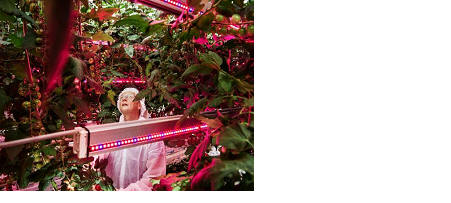
Do tomatoes grow best when bathed in LED light from above, beside, or some combination? Plant scientist Henk Kalkman is seeking the answer at the Delphy Improvement Centre in Bleiswijk. Collaboration between academics and entrepreneurs is a key driver of Dutch innovation.
The challenge? Put in bluntly apocalyptic terms, he says, the planet must produce “more food in the next four decades than all farmers in history have harvested over the past 8,000 years.”
That’s because by 2050, the Earth will be home to as many as 10 billion people, up from today’s 7.5 billion. If massive increases in agricultural yield are not achieved, matched by massive decreases in the use of water and fossil fuels, a billion or more people may face starvation. Hunger could be the 21st century’s most urgent problem, and the visionaries working in Food Valley believe they have found innovative solutions. The wherewithal to stave off catastrophic famine is within reach, van den Ende insists. His optimism rests on feedback from more than a thousand WUR projects in more than 140 countries and on its formal pacts with governments and universities on six continents to share advances and implement them.
A conversation with van den Ende is a white-knuckle ride on a torrent of brainstorms, statistics, and predictions. African drought? “Water isn’t the fundamental problem. It’s poor soil,” he says. “The absence of nutrients can be offset by cultivating plants that act in symbiosis with certain bacteria to produce their own fertilizer.” The soaring cost of grain to feed animals? “Feed them grasshoppers instead,” he says. One hectare of land yields one metric ton of soy protein, a common livestock feed, a year. The same amount of land can produce 150 tons of insect protein.
The conversation rushes on to the use of LED lighting to permit 24-hour cultivation in precisely climate-controlled greenhouses. It then detours to a misconception that sustainable agriculture means minimal human intervention in nature.
“Look at the island of Bali!” he exclaims. For at least a thousand years, its farmers have raised ducks and fish within the same flooded paddies where rice is cultivated. It’s an entirely self-contained food system, irrigated by intricate canal systems along mountain terraces sculpted by human hands.
“There’s your model of sustainability,” van den Ende says.
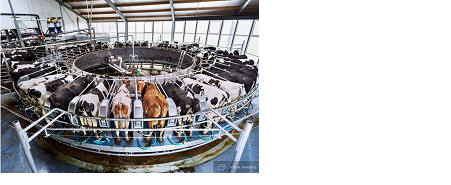
A rotary milking machine enables one operator to milk up to 150 cows an hour at Wageningen University’s Dairy Campus, where researchers seek to address the challenges posed by dairy farming in the densely populated Netherlands.
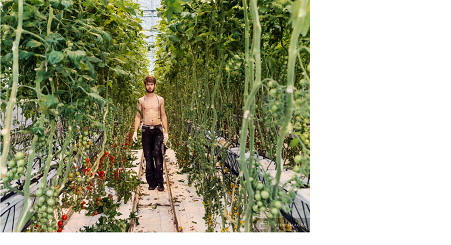
Tomato plants fertilized with fish waste grow taller than urban farmer Paul Jeannet in this rooftop greenhouse located in a former factory in the heart of The Hague. Opened in 2016, the operation includes a produce market and a bar.
At every turn in the Netherlands, the future of sustainable agriculture is taking shape—not in the boardrooms of big corporations but on thousands of modest family farms. You see it vividly in the terrestrial paradise of Ted Duijvestijn and his brothers Peter, Ronald, and Remco. Like the Balinese, the Duijvestijns have constructed a self-contained food system in which a near-perfect balance prevails between human ingenuity and nature’s potential.
At the Duijvestijns’ 36-acre greenhouse complex near the old city of Delft, visitors stroll among ranks of deep green tomato vines, 20 feet tall. Rooted not in soil but in fibers spun from basalt and chalk, the plants are heavy with tomatoes—15 varieties in all—to suit the taste of the most demanding palate. In 2015 an international jury of horticultural experts named the Duijvestijns the world’s most innovative tomato growers.
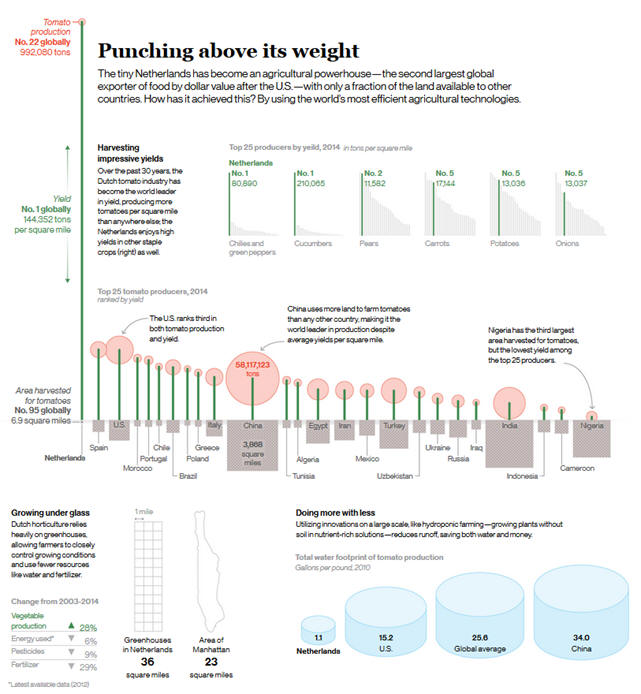
Jason Treat, NGM Staff; Kelsey Nowakowski. Sources: FAOSTAT; Arjen Hoekstra, University of Twente; Statistics Netherlands (CBS)
Since relocating and restructuring their 70-year-old farm in 2004, the Duijvestijns have declared resource independence on every front. The farm produces almost all of its own energy and fertilizer and even some of the packaging materials necessary for the crop’s distribution and sale. The growing environment is kept at optimal temperatures year-round by heat generated from geothermal aquifers that simmer under at least half of the Netherlands.
The only irrigation source is rainwater, says Ted, who manages the cultivation program. Each kilogram of tomatoes from his fiber-rooted plants requires less than four gallons of water, compared with 16 gallons for plants in open fields. Once each year the entire crop is regrown from seeds, and the old vines are processed to make packaging crates. The few pests that manage to enter the Duijvestijn greenhouses are greeted by a ravenous army of defenders such as the fierce Phytoseiulus persimilis, a predatory mite that shows no interest in tomatoes but gorges itself on hundreds of destructive spider mites.
A few days before I visited the Duijvestijns’ operation, Ted had attended a meeting of farmers and researchers at Wageningen. “This is how we come up with innovative ways to move ahead, to keep improving,” he told me. “People from all over Holland get together to discuss different perspectives and common goals. No one knows all the answers on their own.”
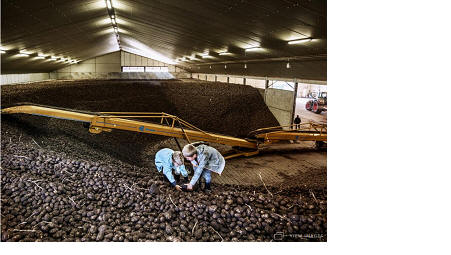
Jan and Gijs van den Borne play on mountains of potatoes grown on their family’s ultra-productive farm, which yields twice the global average. The reason? Drones and other tools assess the health of individual plants and determine exactly how much water and nutrients they need to thrive.
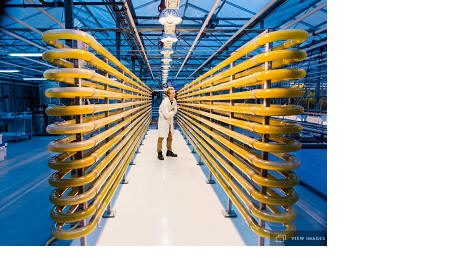
Ruud Veloo monitors an experimental “photobioreactor” at Wageningen University & Research (WUR)’s AlgaePARC. Light fuels the growth of microalgae, which are used to produce proteins and lipids, the basis of many food chains.
The search for answers to a life-or-death question gave rise to one of the Netherlands’ most innovative companies. Half a century ago, Jan Koppert was growing cucumbers on his land and using toxic chemical sprays to fend off pests. When a physician declared him allergic to pesticides, Koppert set out to learn all he could about the natural enemies of insects and arachnids.
Today Koppert Biological Systems is the global pacesetter in biological pest and disease control, with 1,330 employees and 26 international subsidiaries marketing its products in 96 countries. Koppert’s firm can provide you with cotton bags of ladybug larvae that mature into voracious consumers of aphids. Or how about a bottle containing 2,000 of those predatory mites that hunt down spider mites on plants and suck them dry? Or a box of 500 million nematodes that mount deadly assaults on fly larvae that prey on commercial mushrooms?
Koppert’s legions make love as well as war, in the guise of enthusiastic bumblebees. No form of artificial pollination matches the efficiency of bees buzzing from flower to flower, gathering nectar to nourish their queen and helping to fertilize the ovaries of plants along the way. Each Koppert hive accounts for daily visits to half a million flowers. Farmers using the bees typically report 20 to 30 percent increases in yields and fruit weight, for less than half the cost of artificial pollination.
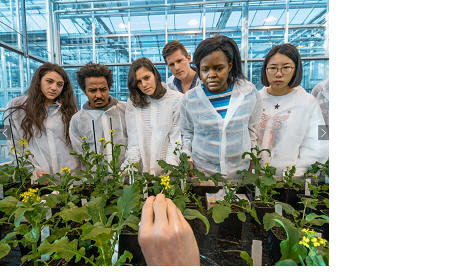
Knowledge is the Netherlands’ most valuable export, say instructors and students at WUR, where half of all graduate students hail from other countries—some threatened by recurring famine.
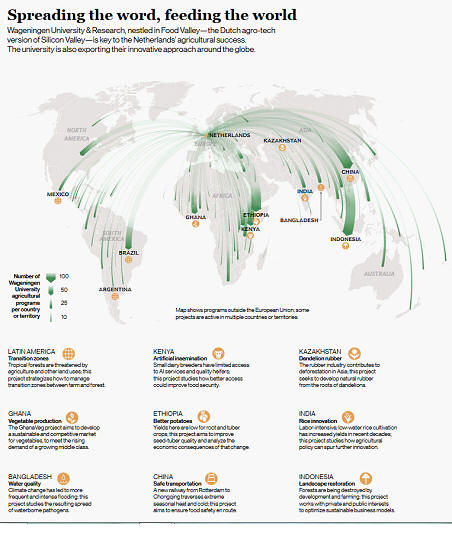
Jason Treat, NGM Staff; Kelsey Nowakowski Source: Wageningen University & Research
Nowhere is the Netherlands' agricultural technology more cutting-edge than in the embryonic organism in which most food is literally rooted: seeds. And nowhere are the controversies that surround the future of agriculture more heated. Chief among them is the development of genetically modified organisms to produce larger and more pest-resistant crops. To their critics, GMOs conjure up a Frankenstein scenario, fraught with uncertainty about the consequences of radical experimentation with living entities.
In New York City, farming on a rooftop is not just an idea. Brooklyn Grange farms more than two and a half acres of rooftops in Brooklyn and Queens, and then sells what it produces to New Yorkers.
Dutch firms are among the world leaders in the seed business, with close to $1.7 billion worth of exports in 2016. Yet they market no GMO products. A new seed variety in Europe’s heavily regulated GMO arena can cost a hundred million dollars and require 12 to 14 years of research and development, according to KeyGene’s Arjen van Tunen. By contrast, the latest achievements in the venerable science of molecular breeding—which introduces no foreign genes—can deliver remarkable gains in five to 10 years, with development costs as low as $100,000 and seldom more than a million dollars. It is a direct descendant of methods employed by farmers in the Fertile Crescent 10,000 years ago.
The sales catalog of Rijk Zwaan, another Dutch breeder, offers high-yield seeds in more than 25 broad groups of vegetables, many that defend themselves naturally against major pests. Heleen Bos is responsible for the company’s organic accounts and international development projects. She might be expected to dwell on the fact that a single high-tech Rijk Zwaan greenhouse tomato seed, priced below $0.50, has been known to produce a mind-boggling 150 pounds of tomatoes. Instead she talks about the hundreds of millions of people, most of them women and children, who lack sufficient food.
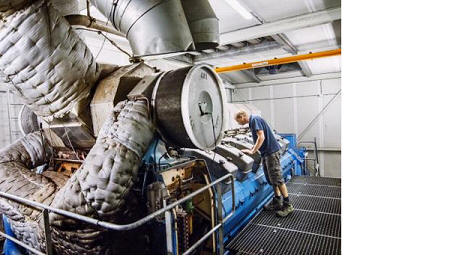
Tomato grower Jasper Oussoren checks a generator that converts natural gas into electricity for lighting. By-products—heat and CO2—are captured and used to warm greenhouses and boost plant growth.
Like many of the entrepreneurs at Food Valley firms, Bos has worked in the fields and cities of the world’s poorest nations. With lengthy postings to Mozambique, Nicaragua, and Bangladesh over the past 30 years, she knows that hunger and devastating famine are not abstract threats.
“Of course, we can’t immediately implement the kind of ultrahigh-tech agriculture over there that you see in the Netherlands,” she says. “But we are well into introducing medium-tech solutions that can make a huge difference.” She cites the proliferation of relatively inexpensive plastic greenhouses that have tripled some crop yields compared with those of open fields, where crops are more subject to pests and drought.
Since 2008 Rijk Zwaan has supported a breeding program in Tanzania at a 50-acre trial field in the shadow of Mount Kilimanjaro. Its seeds are sent to Holland for quality control tests on germination rates, purity, and resistance to pests and diseases. Collaborative projects are under way in Kenya, Peru, and Guatemala. “We try to develop seeds for their specific conditions,” Bos says. But the starting point, she adds emphatically, cannot be the sort of top-down approach that has doomed many well-meaning foreign aid projects.
“We have constant, tremendously important conversations with the small growers themselves—on their needs, on the weather and soil conditions they face, on costs,” she says.
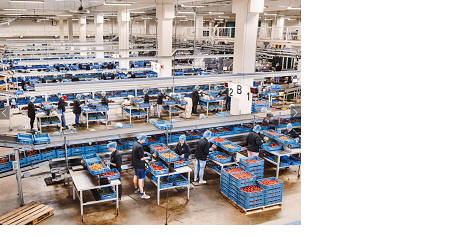
The Netherlands is second only to the United States in global food exports thanks in part to modern processing companies like Greenpack, which ships fresh fruits and vegetables around the clock to markets around the world. Much of the produce is grown in other countries, shipped in bulk to the Dutch port of Rotterdam, packaged for consumers, then moved to markets by air, rail, and sea.
For some Dutch researchers, concern for people threatened by hunger stems in part from a national trauma: The Netherlands was the last Western country to suffer a serious famine, when 10,000 to 20,000 people died in German-occupied lands during the final year of World War II. Decades later, WUR’s Rudy Rabbinge, professor emeritus of sustainable development and food security, took up the cause when he helped devise extensive changes in the faculty, student body, and curriculum that transformed the institution into what he calls “a university for the world, and not simply for the Dutch.” Today a hefty share of the academic and research activities at WUR are focused on problems facing poor nations.
Some 45 percent of its graduate students—including nearly two-thirds of all Ph.D. candidates—are recruited abroad, representing more than a hundred nations. Asians, led by Chinese and Indonesians, outnumber almost all non-Dutch Europeans combined. WUR alumni are found in the highest echelons of agricultural ministries across Africa, Asia, and Latin America.
In a campus cafeteria, I sit down with three of WUR’s most promising students, a description that, not long ago, would have meant male and Dutch born. All three are young women, hailing from Uganda, Nepal, and Indonesia.
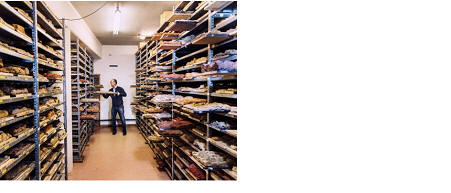
Curator Stephan Mantel oversees the World Soil Museum at WUR. With some 1,200 soil samples from around the world, the collection is a valuable resource for researchers and land-use managers.
“I met a Wageningen alumna when I was an undergrad in Uganda,” Leah Nandudu tells me when I ask how she wound up here. “She was an expert on phenotyping,” the advanced studies that paint a detailed portrait of a plant’s traits and potential. “It inspired me to discover that an African could do these things. She was the future; she was where we need to go.”
The meeting eventually led Nandudu to a WUR scholarship. Her father farms three acres, split between coffee and bananas. Her mother teaches English in a primary school and helps in the field. “We have all the problems farmers face everywhere today, only much worse, especially due to the consequences of climate change.”
Pragya Shrestha was raised in the Nepali countryside, some parts of which have been wracked by years of reliance on pesticides and fertilizers. Sounder, sustainable methods have made few inroads so far.
“It’s a political problem,” she says. New cultivation methods can’t be implemented because of a shortage of public funding. “It’s also a population problem, the fragmentation of the land into smaller and smaller parcels, suitable only for the use of inefficient human labor and generating very little income.”
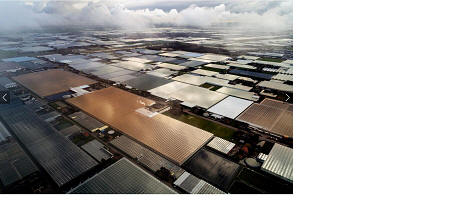
Weather is little worry for farmers in Westland, where 80 percent of cultivated land is under greenhouse glass. The region accounts for nearly half of the Netherlands’ horticultural production.
Renna Eliana Warjoto is from Bandung, the third largest city in Indonesia. “People are mistrustful of ideas that come from abroad,” she says, as Shrestha and Nandudu nod in agreement. “Farmers are so used to having marginal lives and incomes,” she adds, “that they have a hard time believing things could be different.”
In 1944-45 a lethal famine struck the island of Java, where Bandung is located, killing some 2.4 million people. Devastating regional crop failures have haunted Indonesia as recently as 2005. Food supplies periodically run out in rural Nepal because of drought and high prices on essential imports. In 2011 a famine in the Horn of Africa affected 13 million people, and in 2017 1.6 million Ugandans face starvation without rapid assistance from abroad. All these events were unimaginable at the time, yet they pale in comparison to what could lie ahead. The number of people menaced by famine in just three African nations and across the Red Sea in Yemen exceeds 20 million today and is rising inexorably, according to the United Nations. “We are facing the largest humanitarian crisis since the creation of the UN,” the organization’s emergency relief coordinator, Stephen O’Brien, warned in March.
“Our most difficult task is changing the perceptions of our own people—about the crisis we confront and what we must do to address it,” Nandudu says. “That’s my job when I go home. We cannot turn our faces away from reality.”
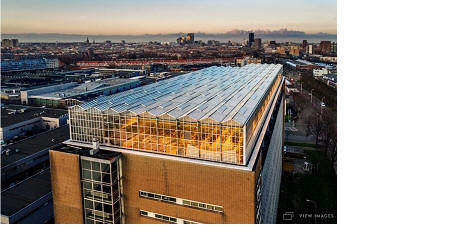
A farm atop a former factory in The Hague produces vegetables and fish in a self-sustaining loop: Fish waste fertilizes plants, which filter the water for the fish. Local restaurants proudly offer the veggies and “city swimmers.”
Some 4,000 miles south of Wageningen, in a family-owned bean field in Africa’s Eastern Rift Valley, a team from SoilCares, a Dutch agricultural technology firm, explains the functions of a small handheld device. In conjunction with a cell phone app, the device analyzes the soil’s pH, organic matter, and other properties, then uploads the results to a database in the Netherlands and returns a detailed report on optimal fertilizer use and nutrient needs—all in less than 10 minutes. At a cost of a few dollars, the report provides input that can help reduce crop losses by enormous margins to farmers who have never had access to soil sampling of any kind.
Less than 5 percent of the world’s estimated 570 million farms have access to a soil lab. That’s the kind of number the Dutch see as a challenge.
“What does our work mean for developing countries? That question is always raised here,” says Martin Scholten, who directs WUR’s Animal Sciences Group. “It’s part of every conversation.
|
|
|
|
Copyright remains with the original authors |